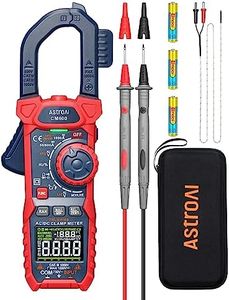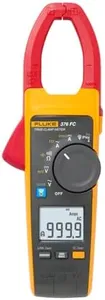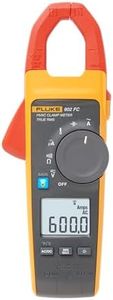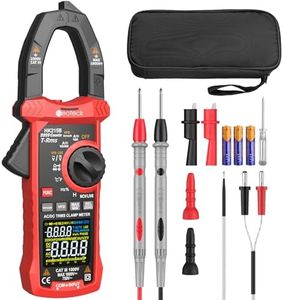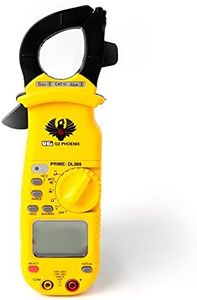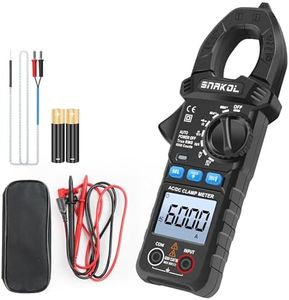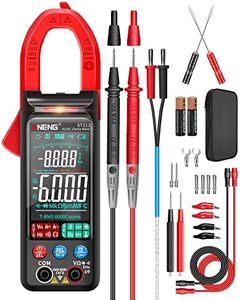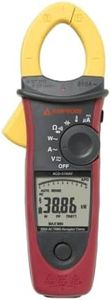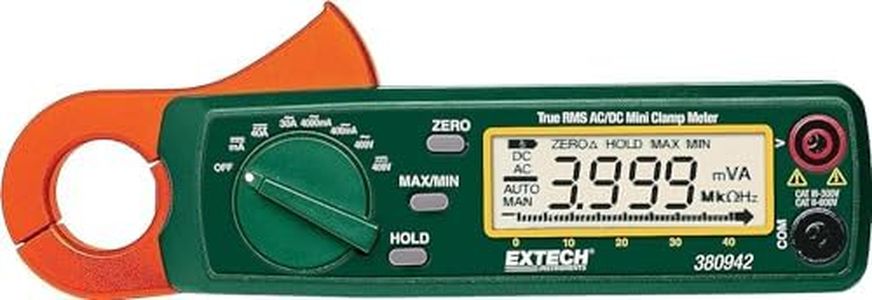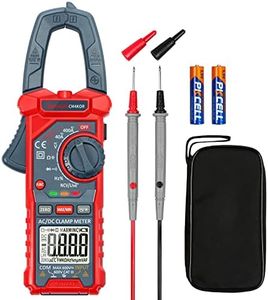10 Best Clamp Meters 2025 in the United States
Our technology thoroughly searches through the online shopping world, reviewing hundreds of sites. We then process and analyze this information, updating in real-time to bring you the latest top-rated products. This way, you always get the best and most current options available.

Our Top Picks
Winner
AstroAI Inrush Digital Clamp Meter Multimeter 1000A TRMS 6000 Counts, Amp Voltage Tester with VFD, LOZ Mode; Measures AC/DC Current Voltage Temperature Resistance Capacitance Frequency Continuity NCV
Most important from
10965 reviews
The AstroAI Inrush Digital Clamp Meter is a versatile tool suited for both DIYers and professionals who need to measure electrical current and voltage safely and accurately. It handles a wide range of measurements, including up to 1000 amps of AC or DC current and voltages up to 1000V DC or 750V AC. This makes it capable of tackling most household or industrial electrical tasks. The meter’s True RMS feature ensures accurate readings even with complex or fluctuating signals, which is important when working with variable frequency drives (VFDs) or non-linear loads. Its jaw opening size and 6000 counts display provide good clarity, and the backlight with flashlight helps when working in dim spaces.
Additional functions like inrush current measurement (for spotting startup issues), low-impedance mode to avoid false readings, and non-contact voltage detection add convenience and safety. The meter includes useful extras such as temperature and capacitance measurement, data hold, and max/min recording, making it a multi-purpose tester. Safety-wise, it meets strong standards (CAT IV 600V and CAT III 1000V), which is reassuring for industrial and solar PV project users.
A noted limitation is that the inrush current feature only works with AC, not DC, and the meter runs on AAA batteries which might require frequent replacements with heavy use. This clamp meter provides a solid balance of accuracy, safety, and useful features at an affordable price, making it a practical choice for anyone needing a reliable electrical testing tool.
Most important from
10965 reviews
Fluke 378FC AC/DC TRMS Non-Contact Voltage Wireless Clamp w/PQ Indicator & iFlex
Most important from
205 reviews
The Fluke 378FC AC/DC TRMS Non-Contact Voltage Wireless Clamp is a solid choice for both professionals and DIY enthusiasts who require reliable and versatile electrical measurement tools. One of its standout features is the FieldSense technology, which allows users to measure voltage and current without needing to make direct contact with live wires. This not only enhances safety but also makes testing quicker and more efficient, especially in potentially hazardous environments. Furthermore, it provides true RMS measurements, ensuring accuracy when dealing with non-linear loads, which is crucial for diagnosing electrical systems accurately.
The clamp's capability to perform complete 3-phase voltage and current tests helps streamline the process, reducing the number of steps needed to gather essential readings. Additionally, the power quality indicator is a valuable feature, alerting users to any issues with the equipment or power line, thus facilitating proactive maintenance.
The display is generally user-friendly, but depending on the lighting conditions, visibility might be an issue for some users, especially in bright sunlight or dim settings. The Fluke 378FC is a feature-rich clamp meter that excels in safety and accuracy, making it suitable for various electrical testing applications.
Most important from
205 reviews
Fluke - FLUKE-376 FC 376 FC 1000A Ac/Dc TRMS Wireless Clamp W/Iflex
Most important from
845 reviews
The Fluke 376FC AC/DC Clamp Meter is designed for industrial and commercial electricians, offering a range of features that cater to their specific needs. It measures both AC and DC currents, with a robust current measurement range, making it versatile for various electrical applications. The inclusion of the iFlex current probe allows measurements in tight spaces, thanks to its flexible design. This can be particularly useful when dealing with complicated wiring setups.
One of the standout features is the True RMS capability, which provides accurate readings even for non-linear loads, a common scenario in modern electrical systems. The inrush measurement function helps to capture the initial surge of current, which is essential for diagnosing equipment behavior.
The Bluetooth connectivity is another significant advantage, allowing electricians to connect the meter to their smartphones. This feature means they can remotely log and monitor measurements, which enhances safety by keeping them at a distance while working on live circuits. The logging capabilities also make it easier to capture intermittent faults without needing constant supervision of the meter.
However, there are some potential drawbacks to consider. While the Fluke 376FC is packed with features, it may be more complex for beginners who aren't familiar with advanced measurements or smartphone connectivity. Additionally, its size could be a concern for those seeking a more compact tool, especially if they need to carry it around frequently. Display and readability are generally good, but in bright light, some users might find it challenging to view the readings clearly. Lastly, as with many professional-grade tools, it comes at a higher price point, which might not be justifiable for occasional users or DIY enthusiasts.
The Fluke 376FC is highly suitable for professionals needing a reliable and versatile clamp meter, particularly in industrial settings. Its advanced features cater well to those who require detailed and accurate electrical measurements.
Most important from
845 reviews
Buying Guide for the Best Clamp Meters
Choosing the right clamp meter can be a bit overwhelming, but understanding the key specifications can help you make an informed decision. A clamp meter is a versatile tool used to measure electrical current without having to disconnect the circuit. It's essential for electricians, technicians, and even DIY enthusiasts who need to troubleshoot electrical issues safely and efficiently. When selecting a clamp meter, consider the following key specifications to ensure it meets your needs and provides accurate readings for your specific applications.FAQ
Most Popular Categories Right Now
